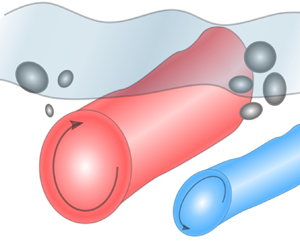Article contents
Modelling entrainment volume due to surface-parallel vortex interactions with an air–water interface
Published online by Cambridge University Press: 14 March 2022
Abstract

We consider the entrainment volume that results from the quasi-two-dimensional interactions of rising surface-parallel vorticity with an air–water interface. Based on systematic (three-dimensional) direct numerical simulations (DNS) of the canonical problem of a rectilinear vortex pair impinging on and entraining air at the free surface, we develop a phenomenological model to predict the resulting entrainment volume in terms of four key parameters. We identify a new parameter, a circulation flux Froude number  $Fr^2_\Xi =|\varGamma |W/a^2\,g$, that predicts the dimensionless volume
$Fr^2_\Xi =|\varGamma |W/a^2\,g$, that predicts the dimensionless volume  $\forall$ of entrained air initiated by a coherent vortical structure of circulation
$\forall$ of entrained air initiated by a coherent vortical structure of circulation  $\varGamma$, effective radius
$\varGamma$, effective radius  $a$, vertical rise velocity
$a$, vertical rise velocity  $W$ with gravity
$W$ with gravity  $g$. For
$g$. For  $Fr^2_\Xi$ below some critical value
$Fr^2_\Xi$ below some critical value  $Fr^2_{\Xi cr}$, no air is entrained. For
$Fr^2_{\Xi cr}$, no air is entrained. For  $Fr^2_\Xi >Fr^2_{\Xi cr}$, the average initial entrainment
$Fr^2_\Xi >Fr^2_{\Xi cr}$, the average initial entrainment  $\overline {\forall }_o$ scales linearly with (
$\overline {\forall }_o$ scales linearly with ( $Fr^2_\Xi -Fr^2_{\Xi cr}$). We also find that
$Fr^2_\Xi -Fr^2_{\Xi cr}$). We also find that  $\overline {\forall }_o$ is linearly dependent on circulation Weber number
$\overline {\forall }_o$ is linearly dependent on circulation Weber number  $We_{\varGamma }$ for a range of vortex Bond number
$We_{\varGamma }$ for a range of vortex Bond number  $5 \lesssim Bo_{\varGamma } \lesssim 50$, and parabolically dependent on circulation Reynolds
$5 \lesssim Bo_{\varGamma } \lesssim 50$, and parabolically dependent on circulation Reynolds  $Re_{\varGamma }$ for
$Re_{\varGamma }$ for  $Re_{\varGamma }\lesssim 2580$. Outside of these ranges, surface tension and viscosity have little effect on the initial entrainment volume. For the canonical rectilinear vortex problem, the simple model predicts
$Re_{\varGamma }\lesssim 2580$. Outside of these ranges, surface tension and viscosity have little effect on the initial entrainment volume. For the canonical rectilinear vortex problem, the simple model predicts  $\overline {\forall }_o$ extremely well for individual coherent structures over broad ranges of
$\overline {\forall }_o$ extremely well for individual coherent structures over broad ranges of  $Fr^2_\Xi$,
$Fr^2_\Xi$,  $We_{\varGamma }$,
$We_{\varGamma }$,  $Bo_{\varGamma }$ and
$Bo_{\varGamma }$ and  $Re_{\varGamma }$. We evaluate the performance of this parameterisation and phenomenological entrainment model for air entrainment due to the complex periodic vortex shedding and quasi-steady wave breaking behind a fully submerged horizontal circular cylinder. For the range of parameters we consider, the phenomenological model predicts the event-by-event dimensionless entrainment volume measured in the DNS satisfactorily for this complex application.
$Re_{\varGamma }$. We evaluate the performance of this parameterisation and phenomenological entrainment model for air entrainment due to the complex periodic vortex shedding and quasi-steady wave breaking behind a fully submerged horizontal circular cylinder. For the range of parameters we consider, the phenomenological model predicts the event-by-event dimensionless entrainment volume measured in the DNS satisfactorily for this complex application.
- Type
- JFM Papers
- Information
- Copyright
- © The Author(s), 2022. Published by Cambridge University Press
References
REFERENCES
- 2
- Cited by





